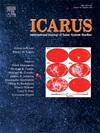Measurement of viscous erosion rate from plume surface interactions in low-pressure environments
IF 2.5
2区 物理与天体物理
Q2 ASTRONOMY & ASTROPHYSICS
引用次数: 0
Abstract
Experimental measurements of viscous erosion rate with regolith simulants were completed under vacuum conditions with a splitter plate, plume cratering setup and non-reacting flows. Using Lunar Highlands Simulant (LHS-1), Lunar Mare Simulant (LMS-1), LHS-1D (Dust) Simulants, this study examined the impacts of bulk density and mass flow rate on crater morphology and viscous erosion rate with ambient pressures between 2 and 760,000 mTorr. Results show that crater shape changes as a function of ambient pressure, owing to plume expansion under vacuum conditions, resulting in annular craters below 1000 mTorr. Erosion rate and ejecta streaking appears to be dependent on the Knudsen number (Kn) and increases with a decrease in ambient pressure. When compared to the continuum region (Kn ≤ 0.1), viscous erosion rate is higher in the free-molecular region (Kn ≥ 10), but the highest measured erosion rates were noted in the transition region (0.1 < Kn < 1) which best corresponds to Martian ambient conditions. A modified version of Metzger's (2024a) equation for volumetric erosion rate is presented using empirical fits for lunar mare and highlands regolith simulants, with limitations discussed. Measurements show that mass flow rate and bulk density can influence viscous erosion rate by 30 % under vacuum conditions, particularly in the free-molecular region. While cohesion clearly influences erosion rate, results suggest that plume dynamics, porosity, and surface roughness may also play an important role in rarified conditions such as on the Moon. To help protect personnel and equipment on future missions, models of plume surface interactions should incorporate these modified equations for viscous erosion.
低压环境下羽流表面相互作用的粘性侵蚀速率测量
在真空条件下,利用分离板、羽流弹坑装置和非反应流完成了模拟风化层粘性侵蚀速率的实验测量。利用月球高地模拟(LHS-1)、月球海模拟(LMS-1)和月球尘埃模拟(LHS-1D),研究了环境压力在2 ~ 76万mTorr之间时,堆积密度和质量流量对陨石坑形态和粘性侵蚀速率的影响。结果表明,在真空条件下,由于羽流膨胀,陨石坑形状随环境压力的变化而变化,导致1000 mTorr以下的环形陨石坑。侵蚀速率和喷出物条纹似乎与克努森数(Kn)有关,并随着环境压力的降低而增加。与连续区(Kn≤0.1)相比,自由分子区(Kn≥10)的粘性侵蚀速率更高,但在过渡区(0.1 <;Kn & lt;1)最符合火星环境条件。本文提出了Metzger (2024a)体积侵蚀速率方程的修正版本,使用月球海和高原风化模拟的经验拟合,并讨论了局限性。测量结果表明,在真空条件下,质量流量和体积密度对粘性侵蚀率的影响可达30%,特别是在自由分子区域。虽然凝聚力明显影响侵蚀速率,但研究结果表明,羽流动力学、孔隙度和表面粗糙度也可能在月球等复杂条件下发挥重要作用。为了在未来的任务中保护人员和设备,羽流表面相互作用的模型应该包含这些修正的粘性侵蚀方程。
本文章由计算机程序翻译,如有差异,请以英文原文为准。
求助全文
约1分钟内获得全文
求助全文
来源期刊

Icarus
地学天文-天文与天体物理
CiteScore
6.30
自引率
18.80%
发文量
356
审稿时长
2-4 weeks
期刊介绍:
Icarus is devoted to the publication of original contributions in the field of Solar System studies. Manuscripts reporting the results of new research - observational, experimental, or theoretical - concerning the astronomy, geology, meteorology, physics, chemistry, biology, and other scientific aspects of our Solar System or extrasolar systems are welcome. The journal generally does not publish papers devoted exclusively to the Sun, the Earth, celestial mechanics, meteoritics, or astrophysics. Icarus does not publish papers that provide "improved" versions of Bode''s law, or other numerical relations, without a sound physical basis. Icarus does not publish meeting announcements or general notices. Reviews, historical papers, and manuscripts describing spacecraft instrumentation may be considered, but only with prior approval of the editor. An entire issue of the journal is occasionally devoted to a single subject, usually arising from a conference on the same topic. The language of publication is English. American or British usage is accepted, but not a mixture of these.
 求助内容:
求助内容: 应助结果提醒方式:
应助结果提醒方式:


